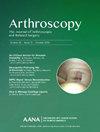生物诱导胶原植入物有望改善肩袖愈合--系统综述
IF 4.4
1区 医学
Q1 ORTHOPEDICS
Arthroscopy-The Journal of Arthroscopic and Related Surgery
Pub Date : 2025-02-01
DOI:10.1016/j.arthro.2024.09.028
引用次数: 0
摘要
目的:本研究旨在系统回顾文献,评估有关生物诱导胶原植入物(BCI)治疗肩袖撕裂的临床研究:方法:根据系统综述和荟萃分析首选报告项目(PRISMA)指南,对 MEDLINE、Embase 和 Cochrane 图书馆进行了文献检索。纳入了对肩袖撕裂进行 BCI 后的临床研究报告。对定量和定性数据进行了评估:结果:共纳入 21 项研究。对于全厚度撕裂的患者,8 项研究中有 7 项研究的术前至术后 ASES 评分显示,术前至术后 ASES 平均评分有显著的统计学改善,75%-100% 的患者达到 MCID。对于部分厚度撕裂的患者,8 项有术前至术后 ASES 评分的研究中有 7 项表明,术前至术后 ASES 评分的平均值在统计学上有明显改善,54.4%-100% 的患者达到了 MCID。在对肌腱厚度增加百分比进行量化的研究中,44% 的全厚度撕裂患者肌腱厚度增加了 13%,部分厚度撕裂患者肌腱厚度增加了 14% 至 60%。有 6 项研究评估了全厚度队列中接受 BCI 治疗后肩袖再次撕裂的情况,报告的比例从 0% 到 9% 不等。有 5 项研究评估了部分厚度人群接受 BCI 治疗后肩袖再次撕裂的情况,报告的比率为 0-18%。其中两项研究发现,由于肌腱愈合率提高,BCI具有成本效益,每条愈合的肩袖肌腱可节省成本5,338-13,061美元:关于使用 BCI 进行肩袖撕裂增量的文献一直都显示出良好的效果。此外,有证据表明,BCI 的再撕裂率低,肌腱厚度持续改善,两项随机对照试验显示,BCI 可改善肌腱愈合。不过,据报道粘连性关节囊炎的发生率似乎较高:IV级,对I、III和IV级研究的系统回顾。本文章由计算机程序翻译,如有差异,请以英文原文为准。
Bioinductive Collagen Implant Has Potential to Improve Rotator Cuff Healing: A Systematic Review
Purpose
To systematically review the literature to evaluate the clinical studies on bioinductive collagen implant (BCI) for the treatment of rotator cuff tears.
Methods
A literature search of MEDLINE, Embase, and the Cochrane Library was performed based on the Preferred Reporting Items for Systematic Reviews and Meta-Analyses guidelines. Clinical studies reporting BCI for rotator cuff tears were included. Quantitive and qualitative data were evaluated.
Results
A total of 21 studies were included. In patients with full-thickness tears, 7 of the 8 studies with pre- to postoperative American Shoulder and Elbow Surgeons (ASES) scores demonstrated statistically significant improvements in mean pre- to postoperative ASES scores, with 75% to 100% of patients meeting the minimal clinically important difference. In those with partial-thickness tears, 7 of the 8 studies with pre- to postoperative ASES scores demonstrated statistically significant improvements in mean pre- to postoperative ASES scores, with 54.4% to 100% of patients meeting the minimal clinically important difference. For studies that quantified percent increases in tendon thickness, the reported increases ranged from 13% to 44% in full-thickness tears and 14% to 60% in partial-thickness tears. Six studies evaluated rotator cuff retears after BCI treatment in the full-thickness cohort, with rates reported ranging from 0% to 9%. Five studies evaluated rotator cuff retears after BCI treatment in the partial-thickness cohort, with rates reported ranging from 0% to 18%. Two of the included studies found that BCI was cost-effective due to the increased tendon healing, with cost savings of $5,338 to $13,061 per healed rotator cuff tendon.
Conclusions
The literature on rotator cuff tear augmentation with BCI has shown consistently reported good results. Additionally, there was evidence of low retear rates and consistently improved tendon thickness with BCI, with 2 randomized controlled trials showing improved tendon healing with BCI. However, there appears to be a higher rate of adhesive capsulitis reported.
Level of Evidence
Level IV, systematic review of Level I, III, and IV studies.
求助全文
通过发布文献求助,成功后即可免费获取论文全文。
去求助
来源期刊
CiteScore
9.30
自引率
17.00%
发文量
555
审稿时长
58 days
期刊介绍:
Nowhere is minimally invasive surgery explained better than in Arthroscopy, the leading peer-reviewed journal in the field. Every issue enables you to put into perspective the usefulness of the various emerging arthroscopic techniques. The advantages and disadvantages of these methods -- along with their applications in various situations -- are discussed in relation to their efficiency, efficacy and cost benefit. As a special incentive, paid subscribers also receive access to the journal expanded website.

 求助内容:
求助内容: 应助结果提醒方式:
应助结果提醒方式:


